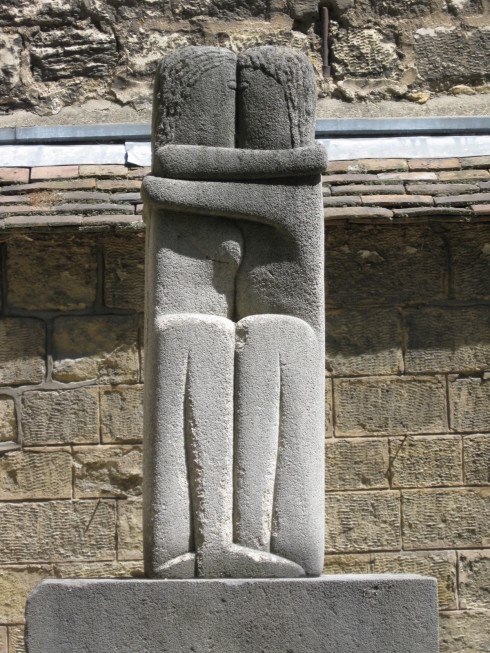Montparnasse Cemetery – A Visit by the Maritime Explorer
Paris has many cemeteries, but three are generally reckoned to be genuine tourist destinations. In spring 2015 I stayed in an apartment overlooking Montmartre Cemetery and wrote this post about my visit. Later I visited Pere Lachaise Cemetery with guide David Burke and wrote this post. Early this spring of 2016 I returned to Paris with my adult daughter Lenore. This morning I’m going to complete the hat trick of great Parisian cemeteries by visiting Montparnasse Cemetery. Won’t you join us?
It’s an absolutely beautiful sunny morning in Paris and Lenore and I decide to walk to Montparnasse Cemetery. That will take us on a route straight through the wonderful Luxembourg Gardens.
Luxembourg Gardens
The Luxembourg Gardens are over four hundred years old and are one of the most popular places for Parisians and tourists alike. The combination of flowers, sculpture, water and a former palace are pretty hard to beat on a day like this. Just outside the gates a vendor is offering these lovely pastel coloured roses for sale.

Inside there are a lot of people lingering around the large pond. Unfortunately at this time of year, the fountains are not on which would make it even nicer, but then again the crowds would be much larger.
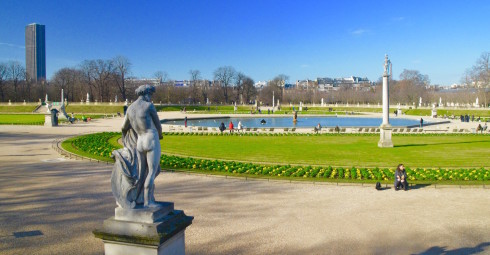
Fortunately the flowers are in bloom, well ahead of their usual schedule. Here is Lenore among the primroses with the dancing faun sculpture and the palace in the background..
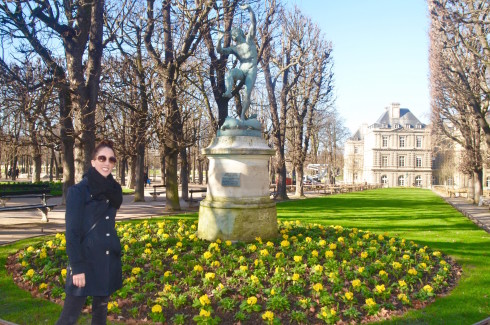
Montparnasse Cemetery
One of the great things about visiting cemeteries is that they are free and yet can provide hours of solitude and reflection with a good history lesson thrown in. While Pere Lachaise and Montmartre cemeteries do have some decent elevation changes, Montparnasse Cemetery does not. Unfortunately even with a wide angle lens, there is no one good spot to get an overall picture of the place, but I did find this photo taken from the top of nearby Montparnasse Tower.

The first thing on entering is to draw up a plan of the grave sites I want to visit and in what order. I’ve already got a list of graves I want see, which I made from the Wikipedia page on line. Like Montmartre, Montparnasse Cemetery provides maps you can borrow that list and identify the most famous burials. As you can see the cemetery is divided into numbered sections. These correspond with markers on the ground so that if you can read a map you should have no trouble finding most of the graves although you might have to hunt a bit to find some of them. I write down the number of each section next to the list of names I have brought with me and soon we are off in search of our first celebrity burial.
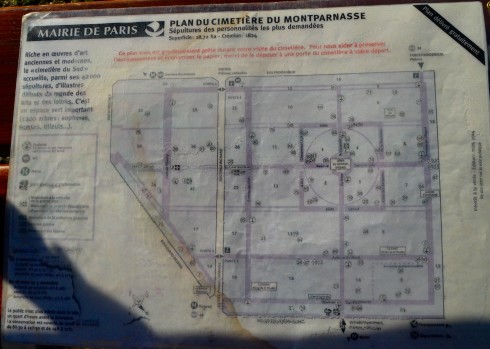
As it turns out the first site we visit has a famous couple interred there – Simone de Beauvoir and Jean-Paul Sartre. Simone is widely credited as being the first modern feminist. Her, at the time, very controversial Le Deuxieme Sexe (The Second Sex) was put on the Vatican Index, but influenced many feminists who followed her in analyzing why women’s roles in society were consistently deemed inferior to men’s. Sartre is of course synonymous with the philosophy of existentialism which I’m not even going to try to explain. It bothered my head way back in undergraduate philosophy and it bothers it today. Simone was initially a student of Sartre’s and later became his lover, partner and friend, but never his wife. Sartre won the Nobel Prize for literature in 1964 and famously declined to accept it some nine years before Marlon Brando pulled the same act and declined to accept his Oscar. It’s also notable that well before Richard Dawkins and Christopher Hitchens were expounding their philosophy of atheism, Sartre had arrived at the same conclusion. The major Paris cemeteries are nondenominational so you well might find a famous atheist buried next to a religious zealot. All are equal in death. Here’s Lenore at the grave of two of the 20th century’s giant intellectuals. People are still bringing tributes.
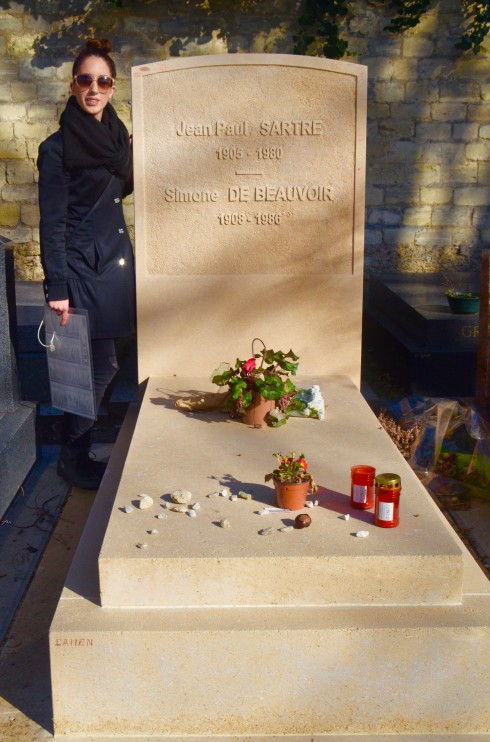
OK, that’s a pretty good start in terms of celebrities. You might not recognize the next guy up, but you can be sure the Mexicans would. Porfirio Díaz was the longest serving president in Mexican history, in office from 1876 to 1911. So why is he buried here and not in Mexico? Díaz, like a lot of dictators, started out popular and as he refused to give up the reins of power and became more and more corrupt, became possibly the most hated figure in Mexican history. After trying to rig an eighth consecutive term in office, he finally triggered a revolution that led to his fleeing the country for Paris where he died not long after. He was perhaps the first of many foreign leaders or opposition leaders who chose the City of Light as their favourite place of exile. Remember even that famous religious nut, the Ayatollah Khomeini chose Paris over say, Mecca as his place to brood over how many people he would have killed when he returned to Iran.
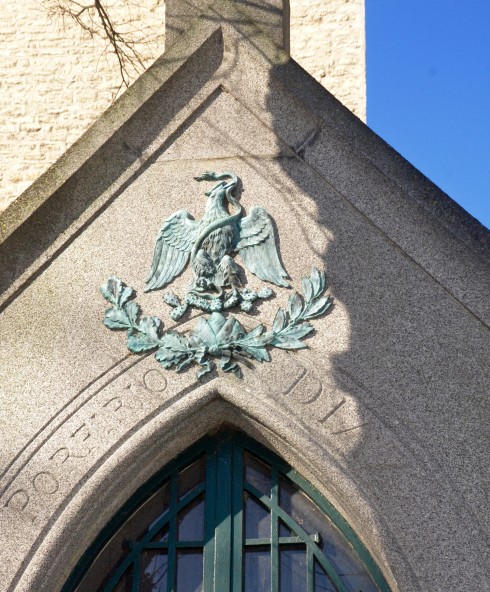
In case you are wondering, that’s the Mexican coat of arms on Díaz’ tomb – a golden eagle killing a snake while sitting on a cactus. I wonder if the Mexicans consider him the eagle, the snake or the cactus?
Let’s move on to a more romantic character. Charles Baudelaire was as close to a French version of Oscar Wilde as you could get. Like Wilde, it was difficult to determine if his life or his art was more interesting. His poems Les Fleurs du Mal (Flowers of Evil) is replete with lesbianism, vampires and all nature of things that were taboo at the time Baudelaire wrote them. Today he is recognized as a poetic genius who was an influence on many who followed including Jean-Paul Sartre. Small world isn’t it.
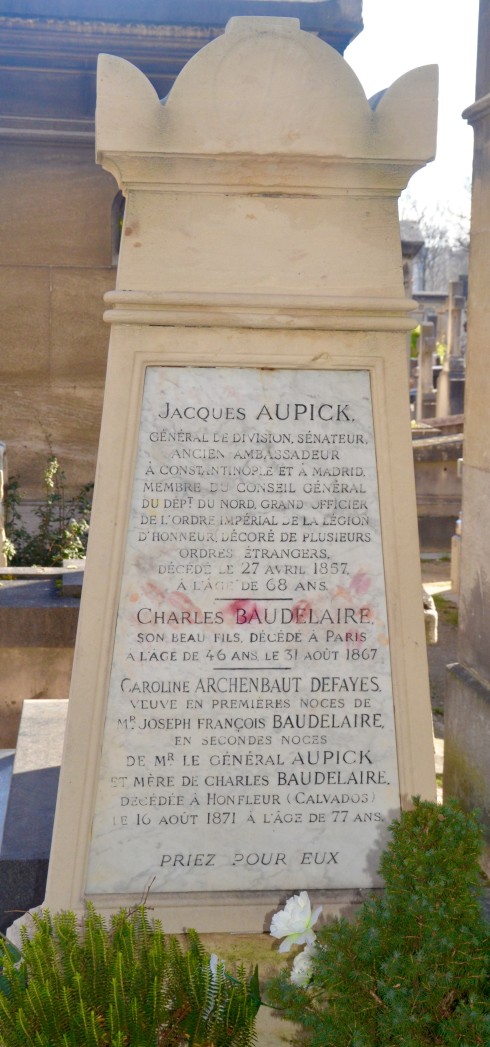
The red marks you see on Baudelaire’s grave are indeed from kisses in red lipstick and reminded me that the same appear on Oscar Wilde’s grave which is in Pere Lachaise. While Baudelaire is indeed buried in this family plot, there is another monument to him on Montparnasse Cemetery. It’s a cenotaph which is a fancy word for a grave marker without a body. Even Charles with his insane lifestyle, couldn’t be in two places at once.
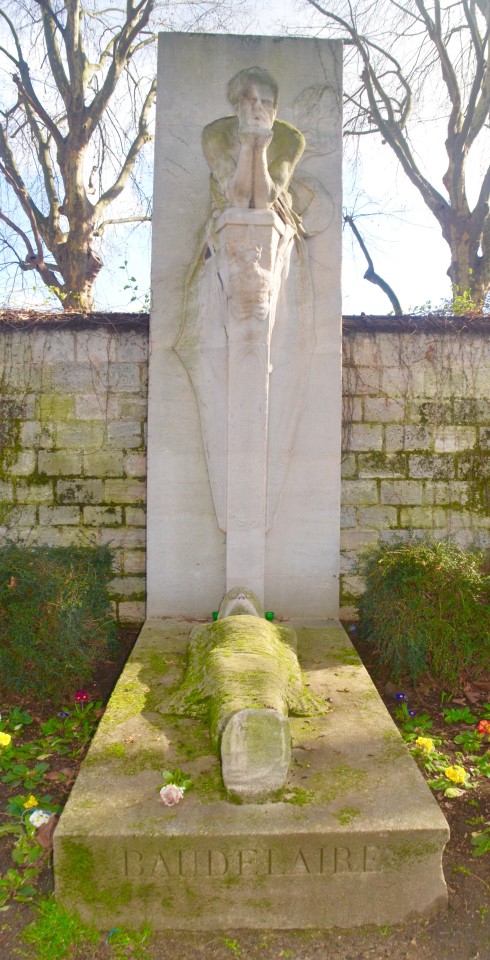
Sometimes it’s worthwhile to stop a grave site not because of who is buried there, but because of the originality of the memorial. This is the grave of Jean-Marie Hatier who was killed on August 20, 1917. I presume he was with the French army at Verdun which records indicate was active there on that date. The face of Christ in the centre of a Celtic cross and the grieving mother is an unmistakeable reference to the crucifixion. I am sure his mother felt as strongly about him as Mary did about her son.
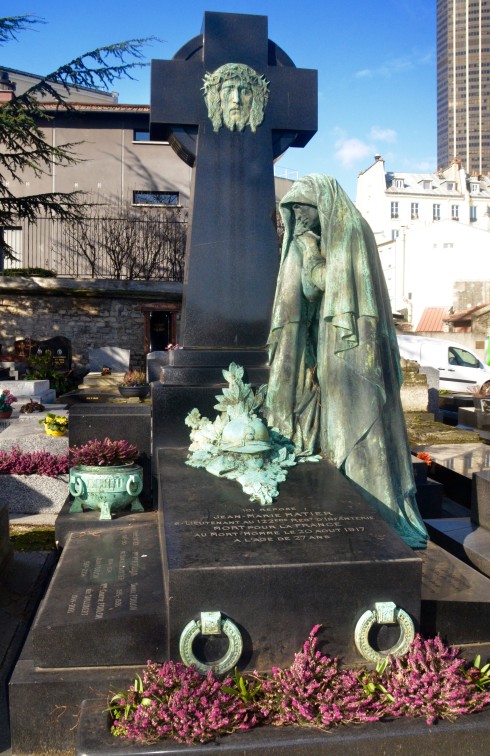
The Paris cemeteries have great pieces of art like the above, but when you become the favourite burial site for famous sculptors, then things get really interesting. Henri Laurens was greatly influenced by Cubism which he later repudiated as you can tell by the rounded lines of his final testament.
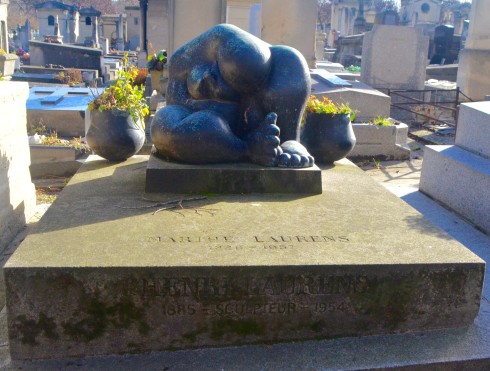
I wrote of Paris as a favourite place for exiled politicians and here’s another one. Chapour Bakhtiar was the President of Iran when that guy I mentioned earlier, Ayatollah Khomeini returned from his exile to drive this man out, and he chose Paris. Bakhtiar was a Sorbonne educated political scientist with no great religious bent. He was an opponent of the Shah as was Khomeini. That didn’t stop Khomeini from having Bakhtiar assisinated in Paris in 1991. Makes you wonder why the Iranians didn’t assassinate Khomeini when they had the chance. Iran is so much better off these days under the mullahs. Not.
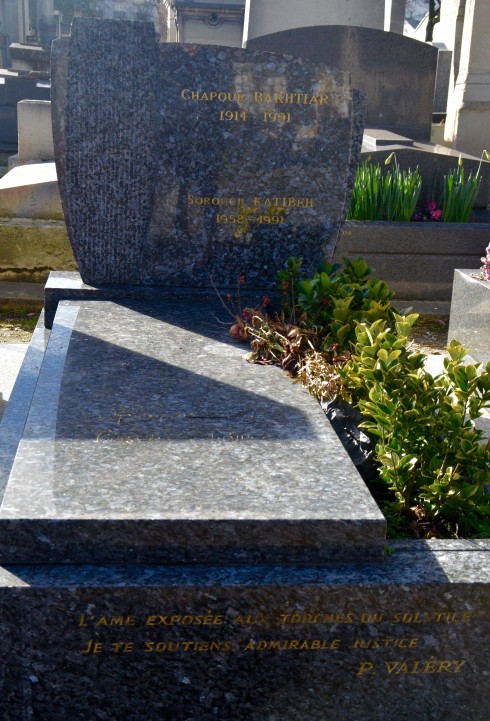
Continuing on the dead sculptor theme here is Baltasar Lobo, a Spanish sculptor who hobnobbed with Picasso and Matisse. It appears to be a figure holding a cane, kneeling in grief, but don’t quote me on that.
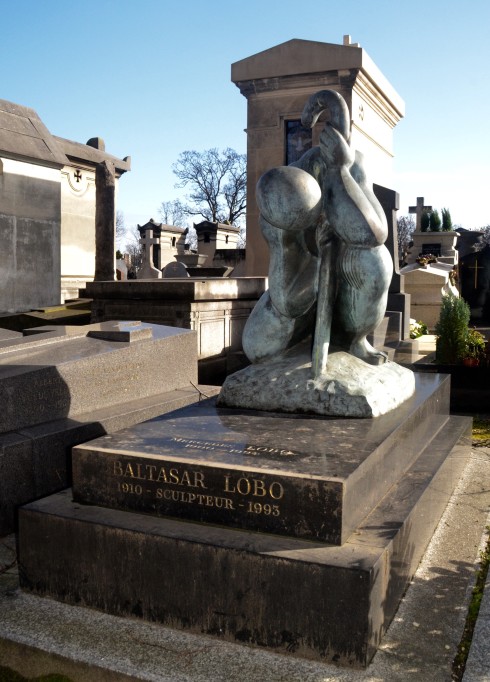
This next grave was surprising to me as Pierre Laval is one of the most reviled people in French history. After serving a couple of terms as French Prime Minister in the 1930’s he returned to head up the traitorous Vichy regime from 1942 until the liberation in 1944. Under his rule much of France’s Jewish population was rounded up and sent east to the extermination camps. He also went on the radio to ask the French people not to help the D-Day invaders. After the war Laval tried to do the disappearing Nazi act, but was caught, put on trial and shot by a firing squad. If I was a Christian, which I’m not, I would demand they remove the cross from this guy’s grave.
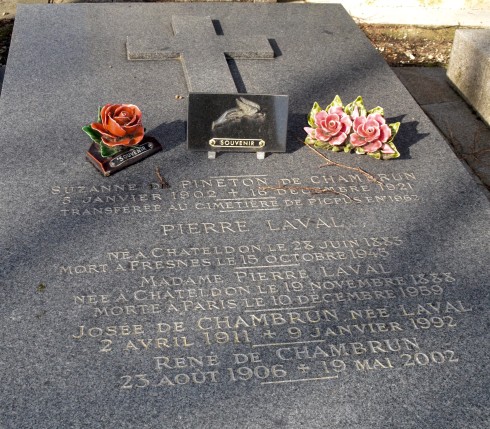
Here’s someone who’s hoping Pierre Laval is rotting in hell. One of his victims lying not more than fifty feet away. I can’t find anything out about who Elie Nordon was, but he died in Auschwitz in 1943.
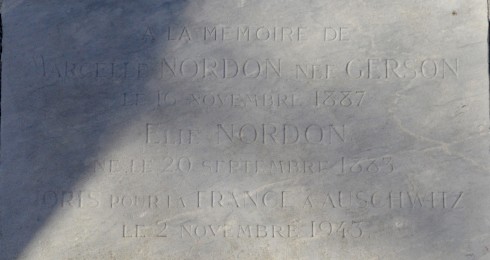
We’re about halfway through our visit to Montparnasse Cemetery when we come to the Moulin Tower, which just means the mill tower. It is in the dead centre of the place. Behind it is the modern Tour Montparnasse which is one of the tallest buildings in Paris.
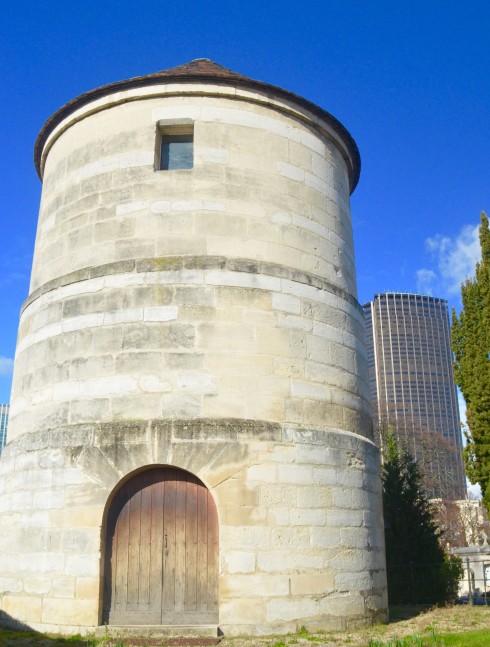
Next up is one of the most mysterious grave sites you’ll find anywhere. It is in the shape of a fish and has these words written on it “Il fait son choix d’anchois et dîne d’une sardine” which translates to “He dines with a sardine and chooses anchovies”. There is nothing else – no name, no dates, nada. I did find out from the internet that the Sardine was a product of Alex Berdal’s workshop in France, but not who commissioned it. On the opposite side there is a pair of breasts. I have to think that whoever is buried here was one hell of a practical joker.
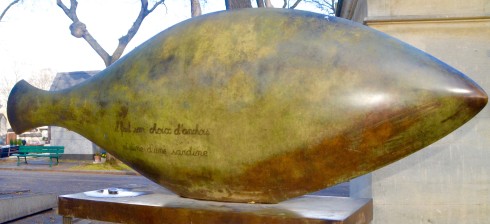
The next person we’ll visit is an American that I was quite surprised to find buried in Paris, because most of her career was spent in New York and that’s where she died in 2004. Susan Sontag was a polymath who produced books, essays, criticism, plays and movies as well as being a well known peace activist. She was a divisive figure too many. Some revered her while others loathed her as being a hypocrite and phoney. One of those who revered her was renowned photographer Annie Liebovitz with whom she had a close relationship from 1989 until Susan’s death in 2004. It’s still not clear if the relationship was more than platonic and Annie’s keeping mum on it, but Sontag made no bones about the fact that she was bisexual.
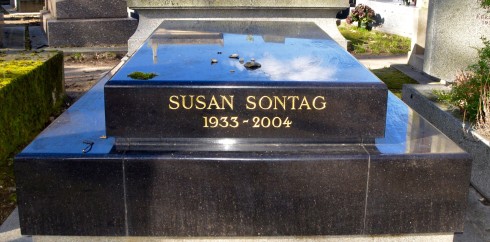
Trying to find out why she is buried in Montparnasse Cemetery and not in New York has not been easy. Her official website which is linked above, makes no mention of her being in France, but the Wikipedia entry does reference a time in Paris which is described as being very important to her so maybe that’s the answer.
Pierre-Joseph Proudhon is not a household name to most, but he was one of the 19th century’s greatest thinkers and is considered the spiritual founder of the anarchist movement. Unlike modern pinheads like Rand Paul, he was a true libertarian who came from dirt poor roots and aspired that all men be treated equally, without the necessity of having an actual government. For that he managed to get himself imprisoned a few times and occasionally had to flee the country. In his first book “What is Property” he famously declaimed “Property is theft!”. Pretty easy to understand what Karl Marx did with that thought. So this enormously influential man now lies under this nondescript headstone and most people just walk on by.
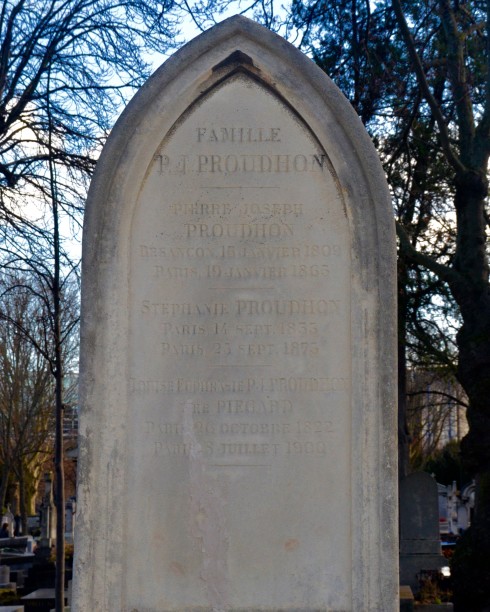
Number thirteen on our Montparnasse Cemetery tour is another controversial figure, Samuel Beckett. The talented Irishman was a francophile who lived in France most of his life including fighting for the resistance in WWII and receiving the Croix de Guerre for his efforts. He wrote novels, poems and short stories but is best known for his plays which where often characterized as Theatre of the Absurd. I can still remember being assigned to read Waiting for Godot in English 101 and after a few pages thinking “What the F*** is this all about?”, but over the years I’ve come to appreciate that play and others by Beckett even though they are quite frankly, absurd. BTW he is the second Nobel literature laureate we’ve met this morning.
Here I am doing best Vladimir (or is it Estragon?), imitation at his gravesite. I look absurd.
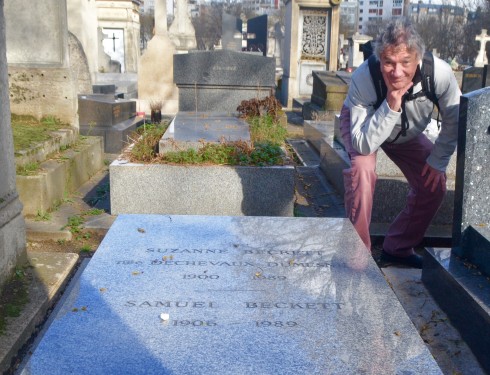
Ever wonder why one person’s gravesite gets a lot more love than others? I think it often has to do with the fact that the person died before their time, e.g. Jim Morrison in Pere Lachaise or Elvis in Graceland. In Montparnasse Cemetery I think the winner is the grave of Jean Seberg, the American actress who began her career playing a Frenchwoman, Joan of Arc. Jean was not really a great actress, but it was the circumstances of her death at age 40 from a barbiturate overdose, that continue to keep her alive in people’s memories. She used the money she made from acting to support activist causes including the Black Panthers. The FBI under that insidious pervert J.Edgar Hoover used its influence to get her blacklisted and made her part of their infamous COINTELPRO project. Hoover apparently reported directly to that paragon of virtue John Ehrlichman about her activities including ones he made up. She probably did commit suicide, but like Marilyn Monroe, we’ll never know for sure.
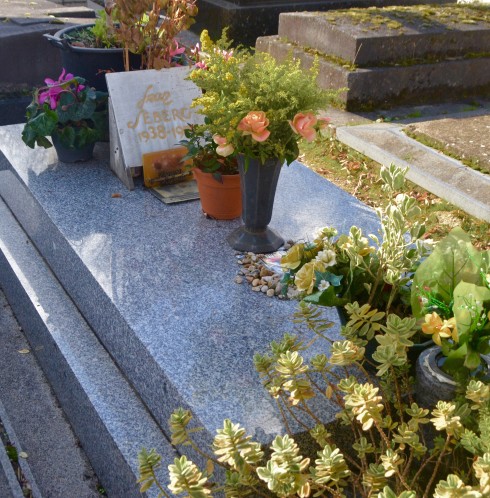
The next gravesite was not on my pre-planned list, but the moment I saw it I knew it had to be included. It’s yet another dead sculptor with some of his finest work sitting on top of him. The sculpture is The Prophet and the artist is Leopold Kretz, a moderately successful Polish artist. The wording translates as ‘My Work is My Prayer’.
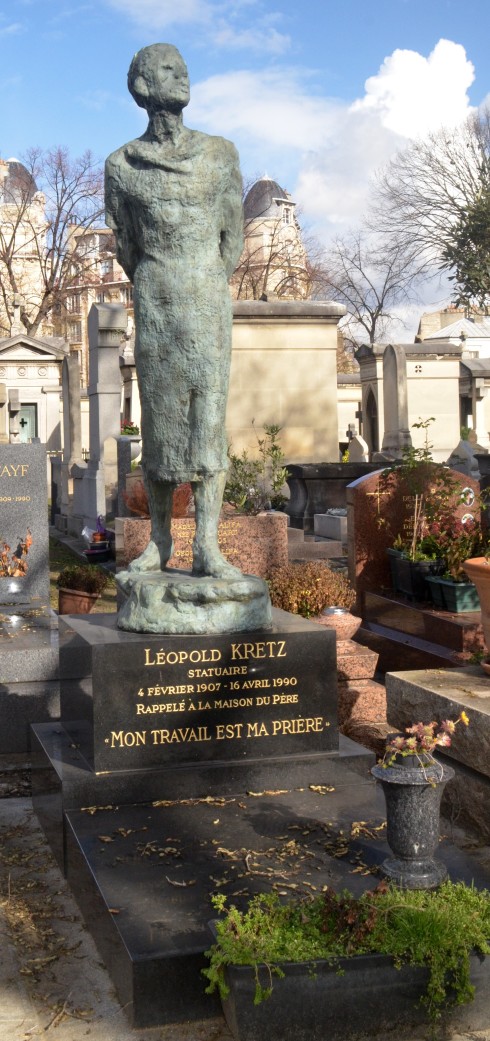
The next gravesite is pure whimsy. It’s Ricardo the Cat by artist Niki de St. Phalle who created it for Ricardo Menon who was a human and not a cat.
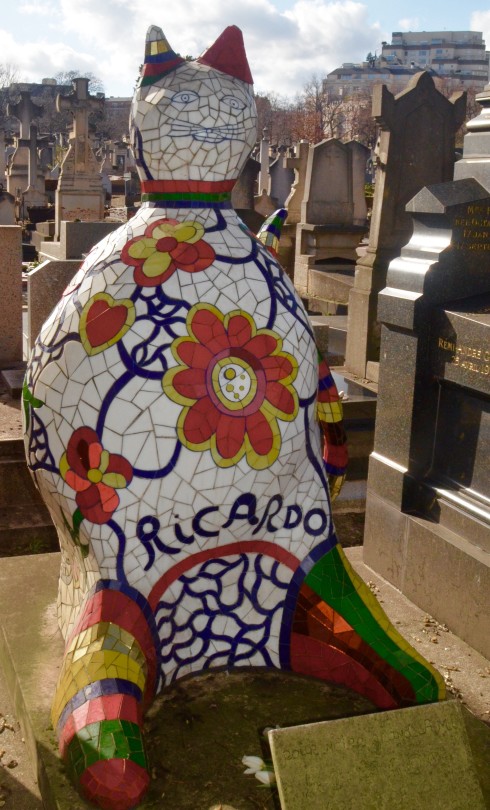
Someone I expected to have an outrageous gravesite, instead has one of the simplest and most moving. Man Ray is yet another of the famous people buried in Montparnasse Cemetery who were genuine geniuses because they could work in so many fields and master them all. In Man Ray’s case that would be painting, photography, sculpture, poetry and film. In painting alone he is noted for surrealism, Dada, Cubism and Futurism. He is buried with his wife Juliet. His epitaph is “Unconcerned, but not indifferent”. Get your head around that. Juliet’s is simply “Together Again”.
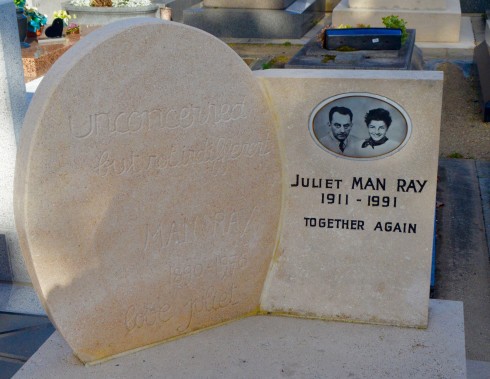
Here’s another radical artist, sculptor César Baldaccini or just César as he was usually referred to and he has certainly bought into the, my statue is better than yours, game. Baldaccini was best known for creating sculptures from objects that he found and this centaurlike creation appears to be cobbled together with different parts.
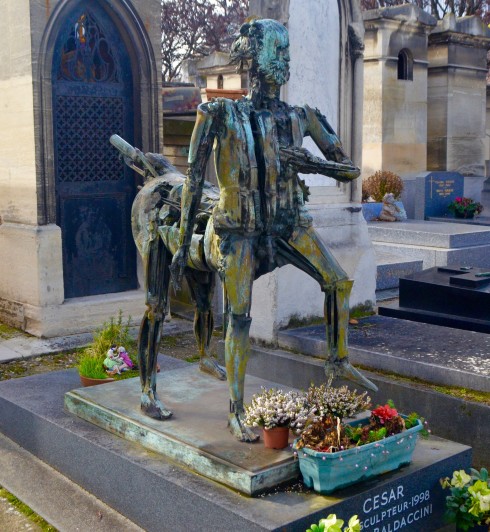
Next is a sculptor who didn’t play the, my statue is better than yours game. Constantin Brancusi is arguably the most important 20th century sculptor and yet he’s opted for tradition and simplicity for his gravesite. As if reading my thoughts a cemetery workman came over and said there was a huge Brancusi sculpture just outside the gates. I’ll have to look for it when we’re finished in here.
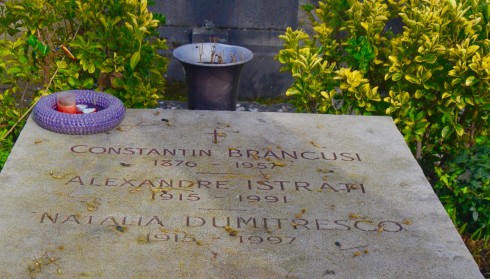
There is another Niki de St. Phalle creation in Montparnasse Cemetery and this time it’s a bird or maybe a birdman. The epitaph is “To my friend, Jean Jacques, a bird that flew away too soon.”
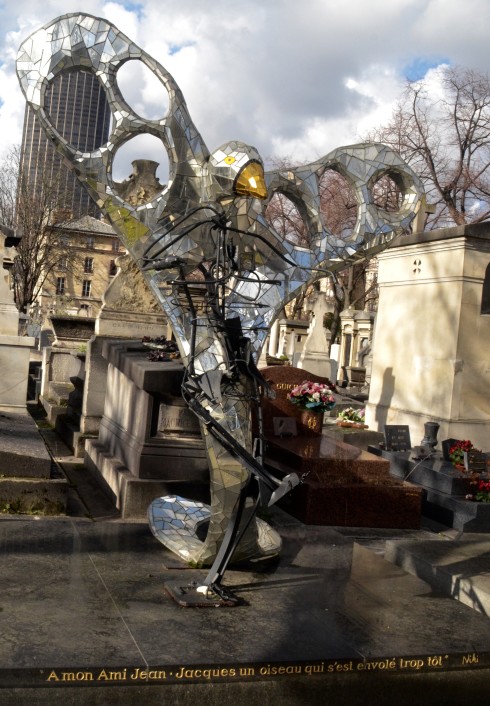
This next one falls into the category of magisterial funereal art. Charles Pigeon, the inventor of a non-exploding bicycle lamp, is today more famous for this beautifully cast sculpture of Pigeon and his wife in bed. There’s an angel standing guard over them that you can’t see. For some reason he’s got a pencil and paper with him, maybe to write down his last words.
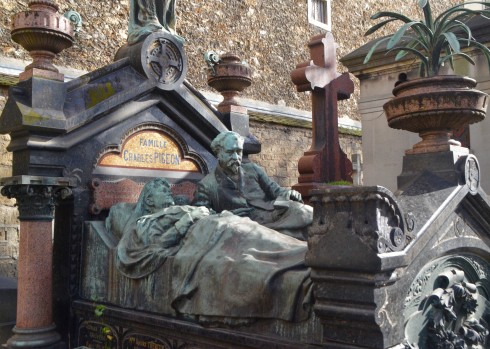
I’m generally not that interested in the tombs of deceased financial magnates or tycoons because the very size of the monuments to themselves is off putting. OK so you made a lot of money. BFD. But sometimes I can be surprised; not by the ostentation, but rather the lack of it. That’s the case with the graves of the Citroen family, of which André Citroën was head.
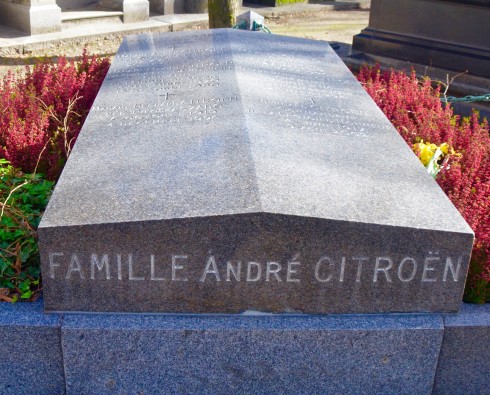
The next to last grave we’ll visit today belongs to one of the most famous Frenchmen in history and not because of what he did, but what was done to him. Alfred Dreyfus, a Jewish member of the military, was framed for treason and even though it was apparent almost from the beginning who the real traitors were, it took twelve years to overturn his conviction. The case deeply divided France and exposed the ugly underbelly of anti-Semitism in the country. It became known simply as L’Affaire. Alfred Dreyfus was one of the first to have a wrongful conviction overturned and it would be nice to say that it led to a more careful look into the evidence for future trials, in France and elsewhere. But if I wrote that I’d be lying. Wrongful convictions are still happening at alarming rates and there are those who oppose overturning them because it would make the justice system look bad. For them it’s preferable for the system to be rotten as long as it doesn’t look rotten. Dreyfus gets people like me worked up to this day.
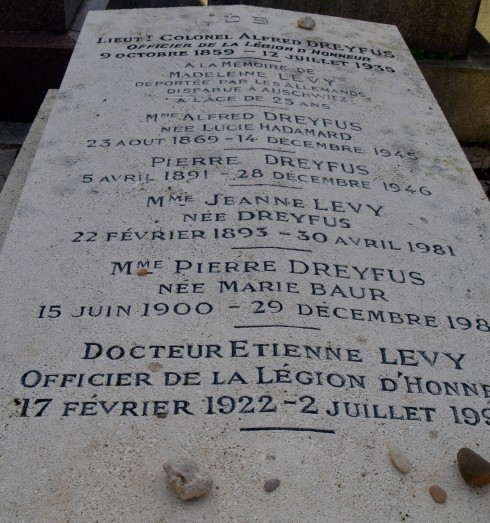
The last grave is that of another sculptor, but one who worked on such a grand scale that he changed the face of New York harbor. I’m referring of course to Auguste Bartholdi the man who designed and built the Statue of Liberty. There several replicas of it in various places around Paris and you’ll find examples all around the world. It’s simply the most iconic statue ever created and the one on Bartholdi’s grave is pretty good too.
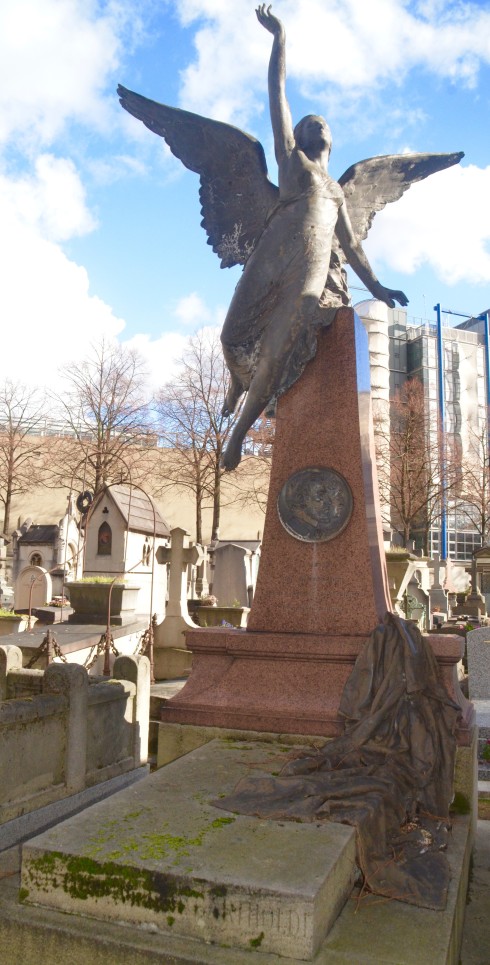
Well that concludes our tour of Montparnasse Cemetery, but I still need to look for that Brancusi sculpture. Oh, there it is, on the boulevard just outside the gate. Except it’s not.
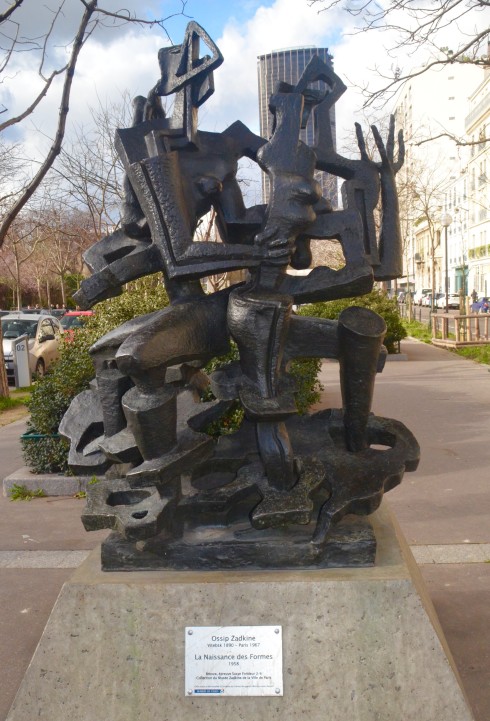
I don’t know if the cemetery workman was misinformed or was pulling my leg, because this work is by Ossip Zadkine. Later I discover there is a Brancusi sculpture in Montparnasse Cemetery atop the grave of a Russian anarchist. Here’s what it looks like and gives me a reason to return and you too.
